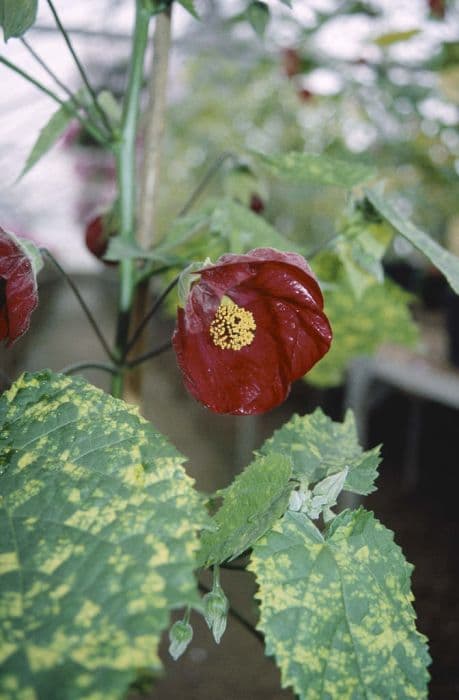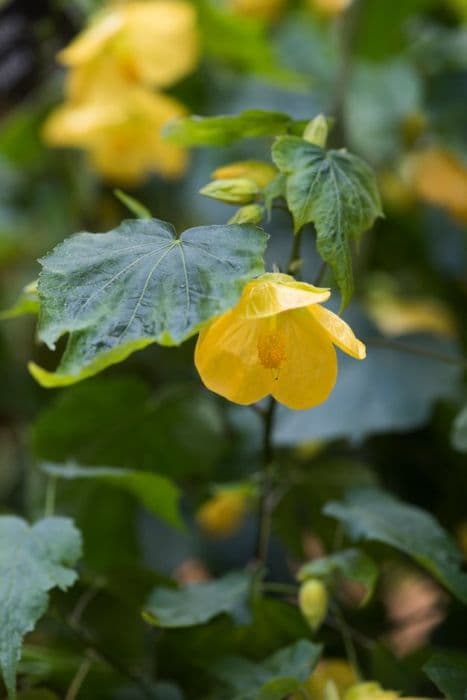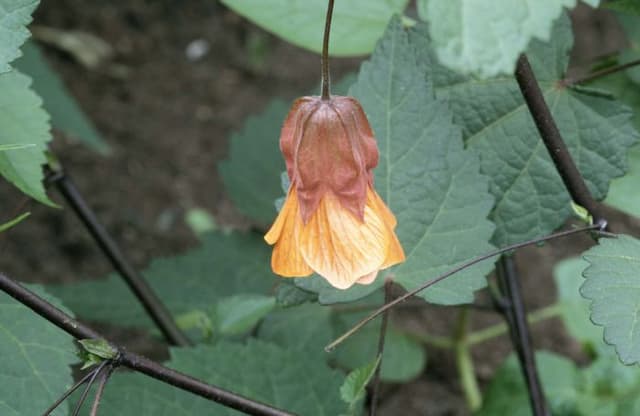Flowering Maple Abutilon 'Marion'

ABOUT
Abutilon 'Marion', commonly known as the Marion flowering maple, exhibits a lush and ornamental appearance. This plant showcases a rich display of bell-shaped flowers that dangle elegantly from its branches. The blooms are a mesmerizing shade, often a blend of soft yellows and oranges, which can add a tropical warmth to any setting. Its petals are slightly overlapped and have a delicate, crepe-like texture that underscores their intricate beauty. The foliage of Marion flowering maple is equally attractive, with broad, maple-like leaves that provide a dense and heart-shaped canvas of greenery. These leaves offer a lovely contrast to the colorful flowers, featuring prominent veining and a slightly toothed edge, contributing to the plant's overall decorative quality. With its appealing combination of vibrant blossoms and lovely leaves, Abutilon 'Marion' is a visually striking plant that serves as an eye-catching specimen in any garden or indoor space where it is cultivated.
About this plant
 Names
NamesFamily
Malvaceae.
Synonyms
Flowering Maple, Chinese Lantern, Marion's Abutilon.
Common names
Abutilon 'Marion'.
 Toxicity
ToxicityTo humans
Abutilon 'Marion', commonly known as Flowering Maple, is not generally considered toxic to humans. There is no significant toxicity associated with this plant, and it is not known to cause poisoning. Therefore, there are no specific symptoms of poisoning or consequences associated with ingesting parts of this plant for humans.
To pets
Flowering Maple is also not commonly regarded as toxic to pets. This means that ingestion of the plant should not cause poisoning in animals such as dogs and cats. There are no well-documented cases of toxicity leading to symptoms from pets ingesting Flowering Maple. However, as with any non-food plant, consumption in large quantities could potentially cause mild stomach upset. It is always prudent to monitor pets around plants and discourage them from chewing on non-food items.
 Characteristics
CharacteristicsLife cycle
Perennials
Foliage type
Evergreen
Color of leaves
Green
Flower color
Yellow
Height
4-6 feet (1.2-1.8 meters)
Spread
3-4 feet (0.9-1.2 meters)
Plant type
Shrub
Hardiness zones
9
Native area
Tropical regions
Benefits
 General Benefits
General Benefits- Ornamental Value: Abutilon 'Marion', commonly known as Flowering Maple, has attractive bell-shaped flowers that add visual interest to gardens.
- Extended Blooming Season: Flowering Maple typically has a long flowering season, often from spring to fall, providing consistent color in the landscape.
- Attracts Wildlife: The flowers can attract pollinators like bees and hummingbirds, enhancing biodiversity.
- Versatility: It can be grown as a houseplant or in a garden, making it suitable for a variety of settings.
- Easy to Care: Flowering Maple is relatively low-maintenance, requiring minimal pruning and care once established.
- Shade Tolerance: It can tolerate partial shade, offering flexibility in garden design and plant placement.
 Medical Properties
Medical PropertiesThis plant is not used for medical purposes.
 Air-purifying Qualities
Air-purifying QualitiesThis plant is not specifically known for air purifying qualities.
 Other Uses
Other Uses- Textile Fiber: Abutilon 'Marion', also known as Flowering Maple, can produce fibers from its bark that have historically been used to make ropes and textiles in some cultures.
- Ornamental Crafts: The stems and seed pods of Flowering Maple can be dried and used in decorative floral arrangements or as part of wreaths and other ornamental crafts.
- Paper Making: The fibers from Flowering Maple can be used in papermaking, providing a unique texture and quality to handmade papers.
- Insulation Material: The fibrous material from Flowering Maple's bark can be used as a natural insulation material in building projects.
- Watercolor Painting: The leaves of Flowering Maple can be pressed and used to create natural patterns in watercolor paintings.
- Dye Production: The flowers and leaves of Flowering Maple may be used to produce natural dyes for coloring fabrics or other materials.
- Natural Insect Repellent: Some gardeners plant Flowering Maple as a companion plant since it is believed to deter certain pests with its scent.
- Photography: Flowering Maple can be used in photogram creation, where its leaves and flowers are placed on photographic paper and exposed to light to create an image.
- Educational Tool: Schools and educational programs may use Flowering Maple to teach botany and horticulture, because of its interesting growth pattern and leaf shapes.
- Wildlife Shelter: Outdoor plantings of Flowering Maple can provide shelter and food for wildlife, such as birds and butterflies, fostering a biodiverse environment.
Interesting Facts
 Feng Shui
Feng ShuiThe Flowering Maple is not used in Feng Shui practice.
 Zodiac Sign Compitability
Zodiac Sign CompitabilityThe Flowering Maple is not used in astrology practice.
 Plant Symbolism
Plant Symbolism- Protection: Abutilon, commonly known as Flowering Maple, is often associated with shelter and protection due to its large leaves that resemble those of maple trees, providing coverage and a sense of safety.
- Domestic happiness: With its bright and welcoming flowers, the Flowering Maple is said to symbolize warmth, comfort, and joy within the household, contributing to a happy home environment.
- Delicate beauty: The intricate and delicate appearance of its flowers represents beauty and grace, often associated with gentleness.
 Water
WaterFlowering Maple should be watered regularly to maintain evenly moist soil, especially during the growing season. Generally, watering once a week with approximately 1 gallon of water per application will suffice. However, this may vary with environmental conditions like temperature and humidity. It's important not to let the soil dry out completely, but also to avoid over-watering, which can lead to root rot. During winter, reduce watering frequency as the plant goes into a dormant period.
 Light
LightFlowering Maple thrives in bright indirect light but can tolerate some light shade. The best spot for this plant would be near an east- or west-facing window where it receives plenty of light without being exposed to the harsh midday sun. Direct sunlight should be avoided, as it can scorch the leaves.
 Temperature
TemperatureFlowering Maple prefers average room temperatures between 60 and 75 degrees Fahrenheit. It can tolerate a minimum temperature of around 50 degrees Fahrenheit but should not be subjected to temperatures below this, as it is not frost-tolerant. To ensure healthy growth, keep it away from drafts and drastic temperature changes.
 Pruning
PruningPruning Flowering Maple encourages bushier growth and more blooms. Prune in late winter or early spring by cutting back leggy branches and removing any dead or damaged wood. This plant can also be lightly pruned throughout the growing season to maintain its shape. The best time to do extensive pruning is before new growth begins.
 Cleaning
CleaningAs needed
 Soil
SoilThe best soil mix for an Abutilon 'Marion', commonly known as Flowering Maple, is a well-draining, peat-based potting mix. It should have a pH between 5.5 and 6.5. Incorporating perlite or sand can enhance drainage. Adding organic matter like compost will provide nutrients and improve soil structure, promoting healthy growth.
 Repotting
RepottingThe Flowering Maple should be repotted every 2 to 3 years, or when it becomes root-bound. Use fresh potting mix and a slightly larger pot to encourage growth. Early spring is the best time for repotting this plant.
 Humidity & Misting
Humidity & MistingFlowering Maple thrives in moderate to high humidity levels, ideally between 40% and 60%. In dry indoor environments, using a humidifier or placing a water tray near the plant can help maintain optimal humidity.
 Suitable locations
Suitable locationsIndoor
Provide bright, indirect light and keep away from drafts.
Outdoor
Plant in partial shade and shelter from strong winds.
Hardiness zone
9-11 USDA
 Life cycle
Life cycleThe life of an Abutilon 'Marion', commonly known as Marion's Flowering Maple, begins with seed germination, which requires warm temperatures and even moisture. Following germination, the seedling stage is characterized by the growth of the first true leaves after the cotyledons. As the plant enters the vegetative stage, it develops a more robust root system, numerous leaves, and stems, in preparation for maturity. During the flowering stage, Marion's Flowering Maple produces its distinctive bell-shaped flowers which can be various colors including orange, yellow, or red. After pollination, typically by insects, the plant produces fruits in the form of dry capsules that contain seeds, completing the reproductive cycle. Finally, in many climates, this perennial may enter a period of dormancy during colder months before resuming growth in the spring.
 Propogation
PropogationPropogation time
Spring-Early Summer
The most popular method of propagating the Flowering Maple, or Abutilon 'Marion', is by stem cuttings. This technique is typically most successful in the spring or early summer when the plant is actively growing. To propagate by cuttings, a gardener should select a healthy, non-flowering stem and make a cut to obtain a segment approximately 4 to 6 inches (about 10 to 15 centimeters) long. The lower leaves of the cutting are then removed, and the cut end is dipped in a rooting hormone to enhance root development. Afterward, the cutting is placed in a pot filled with a well-draining potting mix, ensuring at least one or two nodes are covered with soil where roots will form. The cutting should be kept moist and placed in bright, indirect light until new growth indicates that it has rooted, which usually takes a few weeks.




![Abutilon [Yellow Trumpet]](/_next/image?url=https%3A%2F%2Fplants-admin.emdemapps.com%2Fimages%2Fplants%2F%2Fimages%2F604b5caa8b4fb.png&w=640&q=75)



